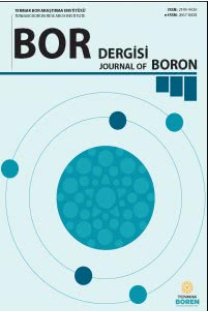Moleküler doking metoduyla SARS-CoV-2 Mpro enziminin aktif bölgesinin incelenmesi ve borlu ilaç geliştirme imkanının araştırılması
Yapılan çalışmalarda COVID-19’a yol açan SARS-CoV-2 virüsünun ana proteaz enziminin (MPro) 2002 yılında ortaya çıkan SARS-CoV virüsünün ana proteaz enzimine %96 oranında benzerlik gösterdiği tespit edilmiştir. SARS-CoV ve SARS-CoV-2 için halen ilaç bulunamamış olduğundan geniş spektrumlu antiviral ilaçların geliştirilmesi büyük önem arz etmektedir. Bu çalışmada, başka hastalıklar için kullanılan FDA onaylı antiviral ilaç moleküllerinin ve literatürde yer alan SARS-CoV ve SARS-CoV-2 için in vitro biyolojik testlerde aktif olduğu bulunan aday ilaç moleküllerinin MPro’ya bağlanma enerjileri AutoDockVina ile hesaplandı. GC-376 kodlu molekülün en düşük bağlanma enerjisine sahip olduğu bulundu (-8.0 kcal/mol). Ayrıca, MPro’ya kovalent bağlanabilecek bor içeren moleküllerin tasarlanma imkânı araştırıldı. MPro enziminin aktif kısmında, yan zincirlerinde -OH grubu olan THR24, THR25, SER46 ve SER144 amino asitlerinin, boronik asit grubu içeren ilaç molekülleriyle kovalent bağlanma yapmaya uygun durdukları bulundu. Bor içeren Bortezomib kanser ilacının da yapı olarak MPro’yu inhibe edebileceği öngörülerek bağlanma enerjisi hesaplandı (-7.0 kcal/mol). Bortezomib üzerindeki boronik asit grubunun yeri değiştirilerek THR24, THR25, SER46 ve SER144 amino asitlerinin -OH gruplarıyla kovalent bağlanmaya elverişli bir posizyona getirilmesiyle elde edilecek regioizomerlerinin bu enzimi daha kuvvetli inhibe etmesi beklenmektedir.
Anahtar Kelimeler:
Ana proteaz, Bortezomib, COVID-19, İlaç yeniden konumlandırma, Moleküler doking
Investigation of active site of SARS-CoV-2 Mpro enzyme and potential of boron based drug development by molecular docking method
In researches on the structure of the SARS-CoV-2 virus, it was found that its Main Protease enzyme (MPro) has 96 % similarity to MPro of SARS-CoV. Since there are still no drugs for SARS-CoV and SARS-CoV-2 viruses, it is quite important to develop broad spectrum antiviral drugs. In this study, the literature data of SARS-CoV-2 in vitro activities of FDA approved drugs that were developed for other purposes were reported. Their binding energies to MPro were calculated by AutoDock Vina. It was found that GC-376 gave the lowest binding energy (-8.0 kcal/mol). Also, the possibility of designing boron containing drugs, which can covalently bind to MPro, was investigated. It was also found that amino acids THR24, THR25, SER46 and SER14, which have -OH side chains and placed in the active site of MPro, are able to form covalent bonds with drug molecules containing boronic acid group. Furthermore, it was predicted that the structure of Bortezomib, a boron containing cancer drug, can also inhibit MPro, having a binding energy of -7.0 kcal/mol. It is expected that designing new regioisomers of Bortezomib by changing the place of boronic acid group in such a way that it is close enough to -OH side chains of THR24, THR25, SER46 and SER14 amino acids to be able to make covalent bonding, will lead to better drug candidates which can inhibit the enzyme more strongly.
Keywords:
COVID-19 SARS-CoV-2, Main Protease, Molecular docking, Drug repurposing, Bortezomib,
___
- [1] Tay, M. Z., Poh, C. M., Rénia, L., MacAry, P. A., & Ng, L. F. P. (2020). The trinity of COVID-19:Immunity, inflammation and intervention. Nat. Rev. Immunol., 20, 363-374.
- ISSN: 2149-9020
- Yayın Aralığı: Yılda 4 Sayı
- Başlangıç: 2016
- Yayıncı: TENMAK Bor Araştırma Enstitüsü
Sayıdaki Diğer Makaleler
Lityum iyon pilleri ayırıcılarında Hekzagonal Bor Nitrür kullanımı ve Gelişmeler
Çekme İşlemi Parametrelerinin Borosilikat Cam Elyaf Kalınlığı Üzerine Etkisinin Araştırılması
Cennet YILDIRIM, Eda TURGUT, Sedat SÜRDEM, Abdulkerim YÖRÜKOĞLU
Bor oksit nanoparçacıklarının dizel yakıt katkısı olarak kullanılabilirliğinin araştırılması
Abdülvahap ÇAKMAK, Hakan ÖZCAN
